The Landcare Trust Award for Innovation in Sustainable Forestry 2019 - Jaap and Sue van Dorsser
New Zealand Tree Grower August 2019.
Jaap and Sue van Dorsser have a wonderful park-like lifestyle block on the banks of the Awahou stream 15 km north west of Rotorua. It has fruit trees and vegetable gardens and a beautiful native tree-lined stream with gin clear water which feeds Lake Rotorua.
They bought this property in 1963 and became proud owners of a stock drovers’ holding paddock with a small abandoned cottage. The stream was unfenced and had suffered from years of neglect in terms of woody weed infestations and open access for the mobs of cattle destined for the Ngongotaha sale yards.
But this story does not start here. It starts when a five-year-old boy moved with his parents to a house surrounded by a 270-hectare nature reserve, mostly forest, in the province of Limburg in southern Holland. Jaap’s father was a seed salesman importing carrot and turnip seed from Belgium, and then selling it to the local farmers. From 1939 to 1945 Holland was occupied by Hitler’s war machine, and locally to the van Dorrser house was a small hill which became the site of an anti- aircraft battery complete with guns and searchlights.
Their house was destroyed during the liberation of Arnhem as their part of the country effectively became the front line. The house was not rebuilt until 1953.
Work history
After the war was finished, Jaap completed his schooling, and then studied at the state college for tropical agriculture in Deventer, Switzerland. In 1953 Jaap left his homeland and family to travel to New Zealand in search of a better life. His only link with home was a college friend called Hans who had a job lined up with the Forest Service. Five weeks after leaving Rotterdam, and two days after disembarking in Wellington, Hans and Jaap arrived at the single men’s camp at the Forest Research Institute in Rotorua. The rest, as they say, is history.
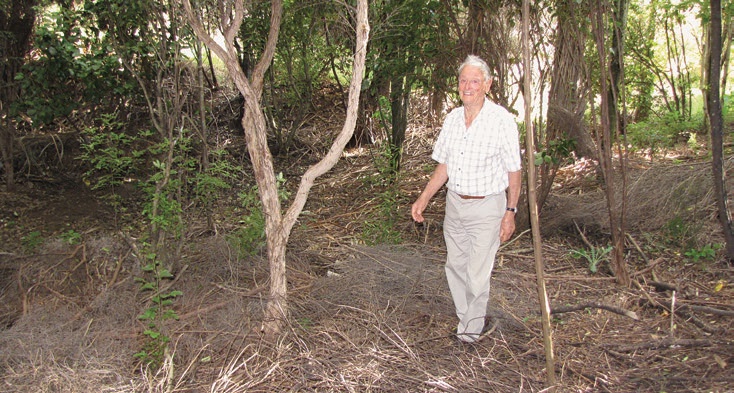
In 1954 Jaap started his employment in the Forest Research Institute nursery where he worked until he retired. During that time Jaap was instrumental in developing many mechanised methods for automating and refining the production of open grown nursery seedlings. These methods included precision seeding, under-cutting and lateral root pruning, wrenching, a steerable tool frame, a fertiliser applicator and a spray machine nicknamed the hocus.
Jaap retired from Forest Research Institute in 1987, and then spent time in India as part of a foreign aid project advising tree nurseries. He then four years in Australia, first in Queensland establishing a forest for woodchip production and latterly in Tasmania.
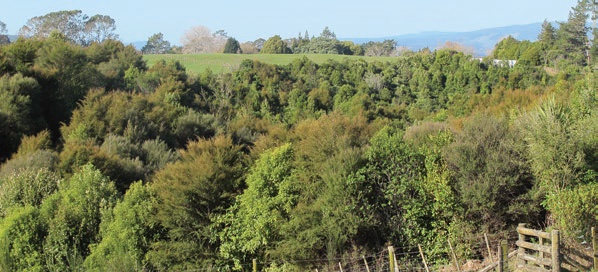
Restoration begins
In 1994 Jaap and Sue started the restoration of the Awahou stream. In 1965 and 1987 Jaap had planted a small corner where the stream was undercutting the banks, but during his working years away had little
time to do much more. Between 1994 and 2014 the Awahou stream care group − Jaap, Sue and friends Ham and Jan Gifford, restored nine hectares of riparian land, much of it on neighbouring properties. This involved clearing blackberry, barberry, willow and other weeds followed by native tree planting to get a native corridor along the stream established. The initial planting mix includes coprosma, pittosporum, manuka, five finger, broadleaf, kanuka, cabbage trees. Then larger forest trees were added to the mix such as totara, rimu, matai, miro, kahikatea and tanekaha.
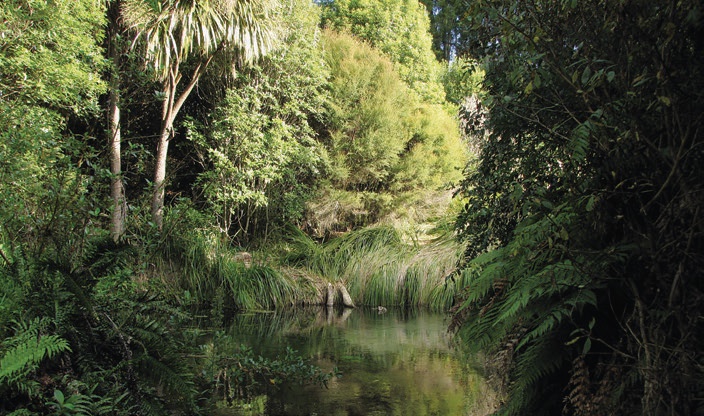
They needed three years of intense weed control to mop up any weed seedlings, a job which lessened once canopy closure took place. After that it was time to move on to the next section, a process which was repeated many times. Tracks were also created along with bridges to cross and re-cross the Awahou, and all the time a wary eye was kept for seedling blackberry and barberry.
How to treat young native trees
What is impressive about this project is the use of appropriate native species to undertake specific tasks. For example, Jaap has discovered that kanuka makes a far better nurse crop for totara than manuka because kanuka has a far more upright growth habit which draws up the totara instead of suppressing them. Another is selecting a rhizomatous native grass for streamside bank reinforcement which lays down when the stream floods and then springs up again.
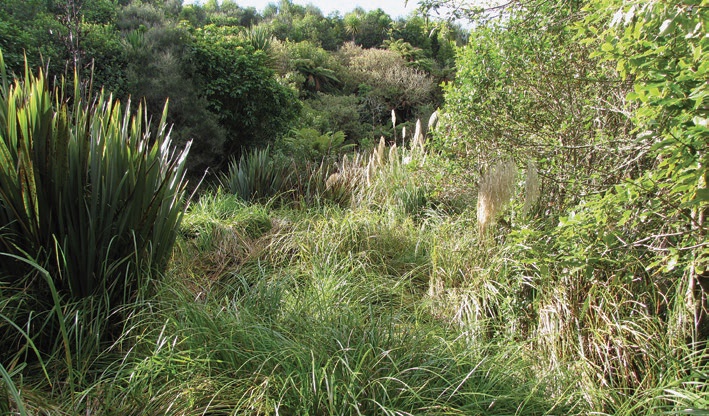
All of Jaap’s early tree stock was open grown and planted bare rooted. They were lifted from the nursery bed, root trimmed, water dipped and bundled in white plastic bags. However, when the supply of bare rooted material ran out he had to resort to getting potted material. He noted that the plants were generally very root bound, and so putting on his nursery innovator hat Jaap set about improving neglected root systems which he describes as his de-bagging practice.
It is a six-part process which starts with the bag being pulled off, then the bottom of the root ball being cut off, then all the potting mix is shaken out. The twisted roots are gently teased down and the dangling roots cut back to around 100 mm long which is what a bare rooted nursery tree would be. Finally the roots are dipped in water and bagged, which makes it all so much easier to cart 20 or 50 trees without all the potting mix. It is this attention to detail which shines out, not only in the Awahou stream project that Jaap led, but many of the other projects which he undertook before this.
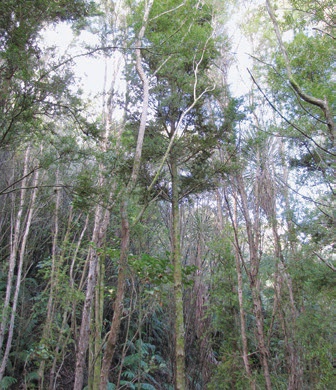
Reversal moment
Jaap has a philosophy that the environment is more important than people because people stuff things up. The only way to counter stuff-ups is to do something to reverse it, and without the environment we have nothing. That philosophy was no doubt partly born when he was a child spectator to the monumental stuff-up that enveloped his homeland in 1939, and his love for the environment has grown throughout his lifetime.
The Awahou stream project is Jaap’s stuff-up reversal moment in what was a weed infested paddock beside a degraded stream. He, along with his wife and friends, have created a wonderful legacy that should be a guide to anyone who was considering such an undertaking.

 Farm Forestry New Zealand
Farm Forestry New Zealand